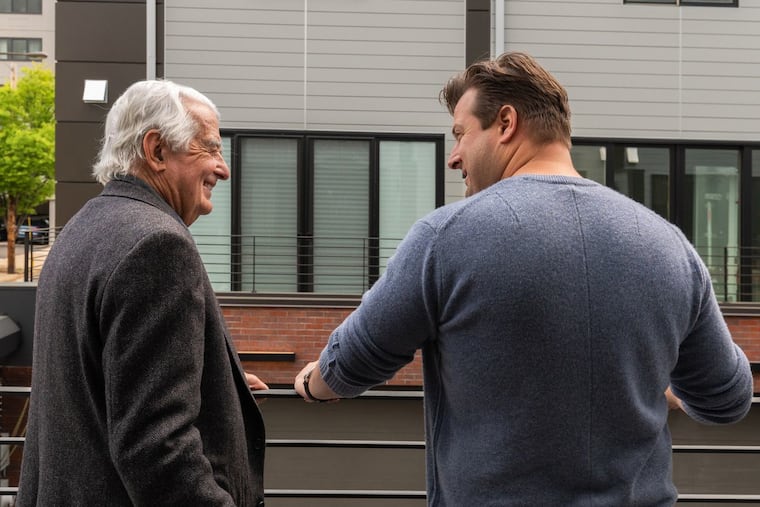The man who designed Philly’s most expensive condo is leaving his architecture firm after 40 years
After designing many of the most prominent high-rise condo buildings in Philadelphia, Cecil Baker is stepping back.

The architect behind some of Philadelphia’s most notable high-end housing towers in recent years, along with a lot of affordable housing, is leaving his own firm 40 years after he founded it.
Cecil Baker and his colleagues at his titular architecture firm designed 500 Walnut, which contains the most expensive home sold in the city’s history, and One Riverside, a prominent condo tower that opened in 2017. But the company also made a name for itself working with nonprofits like New Kensington CDC and Project HOME.
Baker himself also made an impression as a droll — and sometimes cutting — voice in local urban planning debates as an original member of the Civic Design Review (CDR) committee, which critiques major development proposals.
His departure marks the culmination of a career that spanned the years of Philadelphia’s precipitous decline — when he renovated industrial buildings — to its 21st-century revival as homes, population, and new towers rose again.
Queen Village roots
Baker moved to Philadelphia in 1963 to study under the renowned midcentury architect Louis Kahn at the University of Pennsylvania. After graduating, he moved to Queen Village, which was, at the time, home to a hip enclave jostling for space in an older, more established, mostly working-class neighborhood.
From 1972 until 1982, Baker worked as a developer of small projects. With his partners, they were responsible for 300 units, most of them in Queen Village. They also produced a handful of subsidized projects in Chinatown and Washington Square West. They bought old small industrial sites, like the Candy Factory Court at 620 S. American St. and Catherine Commons at 310-312 Catherine St., and turned them into housing — doing much of the masonry and carpentry themselves. In 1982, he opened his own architecture firm.
Developer Tom Scannapieco met Baker in the 1980s as he was transitioning from development back to architecture full time. They worked together on the Waterworks condominiums in New Hope, hanging on the edge of the Delaware River. The units sold for $530 a square foot, the highest-priced condo in Pennsylvania in 1986.
“Back then I just saw him as a creative architect, he hadn’t yet developed his reputation as a modernist, minimalist architect,” said Scannapieco. “That’s grown over the subsequent decades. He has done some of the best residential designs in Philadelphia, hands down.”
‘Why did I settle in Philadelphia?’
Baker says his chief influences are Mexican architect Luis Barragán, who designed minimalist structures in Mexico City, and Philadelphia architects like Kahn or Louis Sauer. In the 1990s and 2000s, he tried to bring their more sensual style, denoted by slender towers and elegant riffs on the Philadelphia rowhouse, to his projects and established his reputation at the higher end of the market.
But Philadelphia is a city known for its historic neighborhoods, and, especially when he was starting out, critics pushed back against those who wished to deviate too much from the norm.
“In the years I’ve been here, there are many times I’ve asked myself, ‘Boy, why did I settle in Philadelphia? Why am I fighting?’” Baker recalled.
At the same time as his firm worked on expensive housing projects, they also devoted their practice to affordable housing developers.
“Affordable housing is often done by a different type of architect who would not otherwise be doing high-end housing,” said Nancy Bastian, managing partner at his firm. “There is no other firm in the city that has this combination of work.”
Lacerating commentary
Baker’s influence on Philadelphia grew in 2012, when the city’s Planning Commission launched the CDR committee, a panel of city-appointed planners, architects, and developers who critique large new proposals. The goal: help major developments better align with existing neighborhood aesthetics.
Alan Greenberger, who was then in charge of the Planning Commission, wanted Baker on board.
“Our decision to recommend him to the mayor was based on the level of design sophistication he was showing at larger and larger scales,” said Greenberger. “Then his commentary on CDR augmented his reputation as a serious designer in town.”
Over the next seven years, Baker became known for thoughtful, witty, and occasional lacerating commentary at the committee meetings. (He critiqued the design of bay windows in many new developments as suffering from “SpongeBob SquarePants syndrome.”)
During this time, Baker began working on the huge condominium projects that would come to define the high end of the market during Philadelphia’s pre-pandemic boom years. Developer Carl Dranoff hired him to design One Riverside, on the banks of the Schuylkill, and Scannapieco retained him for 500 Walnut on the edge of the Independence Hall historic area.
Not retirement
Baker stepped down from CDR in 2019. His decision was two-fold: First, he increasingly had to recuse himself from critique due to his ever-growing portfolio of clients. But also, he’d grown despondent over the board’s lack of power. Developers often ignored the committee’s input. He was especially irked when he specifically cited a self-storage facility on Spring Garden Street where the owners did not implement a single suggested change.
Even with another chapter closing — his last day at his eponymous architecture firm was Dec. 31 — Baker is hesitant to use the R-word (that’s retirement) to describe what’s next.
Baker says he is slowing down after decades of intense work, but he will continue to do some projects, including at his former firm, which is being rechristened CBP Architects.
“This is pictorially a great city with so many beautiful things about it,” he said. “I don’t really want to retire because there’s so many opportunities to make the city a better place. If there’s anything I can do between now and when I kick the bucket, I’d like to.”